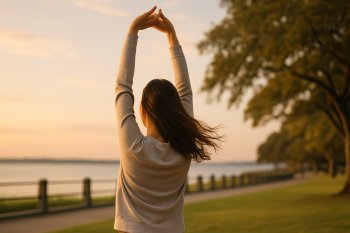
Birth Trauma, Non-Invasive Upper Cervical Solutions
There are approximately 1 out of 9,714 people in the United States who are born with birth trauma – this is 6 to 8 infants out of every 1,000 infants. In this article, we will go over what is birth trauma, what are the most common types of birth trauma, and if upper cervical can be a solution for you.
What is Birth Trauma?
Birth trauma is a difficult birth or injury the baby suffers because of the baby’s size or position during labor and delivery. Some of the conditions that may be associated with a difficult birth leading to birth trauma to the baby include the following:
- Large Baby - A baby is considered to be large if their birth weight is over 4,000 grams (this is 8 pounds, 13 ounces).
- Prematurity - Babies who are born before 37 weeks are considered premature. Birth trauma is more likely to occur in premature babies as their bodies are more fragile and can be injured more easily.
- Cephalopelvic Disproportion - This means the size and shape of the mother’s pelvis is not adequate enough for the baby to be born vaginally.
- Dystocia - Having a difficult birth typically from a large or an awkwardly positioned fetus, the smallness of the maternal pelvis, or by the failure of the uterus and cervix to contract and expand normally.
- Prolonged Labor - Prolonged labor, also known as failure to progress, will last for about 20 hours or more if you are in labor for the first time. If you are having another child, prolonged labor is 14 hours or more.
- Abnormal Birthing Presentation - When the position and presentation of the baby are not ideal. Position refers to which direction the fetus faces and presentation refers to the part of the body that leads the way out.
Types of Birth Trauma
Keep in mind some babies can have forced birth trauma. Forced birth trauma is when there is too much force during labor; this could mean being forced into birth positions or hurrying the process. Listed below are the most common birth traumas as well as birth trauma effects on baby (some of these may occur during forced labor as well):
-
Caput Succedaneum - Caput is a significant swelling of the baby’s soft tissue of their scalp that develops as the baby travels through the birth canal. Some babies may have to bruise in this area, but the swelling from this birth trauma usually goes away after a few days without any problem. Babies who are delivered by vacuum extraction have an increased risk of receiving this trauma during birth.
- Cephalohematoma - The cephalohematoma is an area of bleeding underneath one of the cranial bones. This type of birth trauma can often be seen as a raised lump on top of the baby’s head several hours after birth. The body will absorb this blood over time, taking around two weeks to three months to disappear completely depending on its size. If the bleeding area is large, there is a chance the baby can develop jaundice (yellowing of the eyes and skin) as the red blood cells break down.
- Bruising or Forceps Marks - A baby may show signs of bruising on their head or face as a result of the trauma from passing through the birth canal and make contact with the mother’s pelvic bones and tissues.
- Subconjunctival Hemorrhage - This occurs when the small blood vessels in the eyes of the baby have breakage. This is a very common type of birth trauma and does not cause damage to their eyes.
- Facial Paralysis - Pressure on a baby’s face during labor or birth may cause their facial nerve injury. When the baby cries, you can see if they have this birth trauma if one side of their face has no movement and their eye is unable to close.
- Brachial Palsy - This type of birth trauma occurs when the brachial plexus (a group of nerves that supplies the arms and hands) is injured. The baby loses its ability to flex and rotate their arm.
- Fractures - A clavicle or collarbone fracture is the most common trauma during birth. The baby’s clavicle may break when there is difficulty delivering the baby’s shoulder or during a breech delivery.
- Cerebral Palsy - Cerebral palsy caused by birth trauma affects 10,000 babies each year. The birth trauma effects on a baby who has cerebral palsy are from brain malformation or injury before, during, or shortly after birth. This is a form of paralysis that occurs from an area of the brain that lies dormant or becomes paralyzed, leading to partial or complete muscle paralysis.
Is There a Safe and Natural Non-Invasive Treatment for Birth Trauma?
You may have noticed birth traumas can take a toll on the baby’s body, but it does not mean they cannot be helped.
Even if no physical birth trauma can be seen, the position of the fetus can distort its body, misaligning its upper cervical area and distorting the brain stem’s messages to the baby’s body. When these messages are disrupted, the baby cannot heal as quickly or as successfully and can cause the brain and body confusion – developing stress on their body over time.
This being said, an upper cervical adjustment is a gentle and safe treatment for babies who have had birth trauma.
Even babies who have cerebral palsy caused by birth trauma can see an improvement in function after an upper cervical adjustment, as it allows the brain to stem to completely communicate to the body and heal itself.
If a baby has experienced birth trauma, it is best to seek out upper cervical immediately so that their body will have a higher chance of healing and correcting itself before symptoms from the trauma worsen over time.
How does the upper cervical work when it comes to birth trauma?
Detection and correction to spinal injuries due to birth trauma have been highly beneficial to newborns and children. It is important to note that the upper cervical is very specific, gentle, and safe for all ages and different from general chiropractic.
Upper cervical chiropractors take great care in studying the top two bones of the spine that protect your brain stem – analyzing how it affects the rest of the spinal cord and how misalignment can pinch and disrupt the brain stem’s performance.
The entire nervous system originates from the brain stem and reacts to what happens to the brain stem. Because of this, it can cause many different health problems down the road if the brain stem is not performing as it should.
This is in charge of very significant bodily functions: healing process, blood pressure, digestion, etc. all while sending information from the brain to the body about your skin, joints, and muscles to ensure everything is working properly.
Babies or children who experience birth trauma have a higher chance of healing from it when their upper cervical bones are corrected for the brain stem to breathe and work as it should. Remember, your brain is the most complicated part of your nervous system and the brain stem cannot tell your body how to heal or what it needs if it is disrupted.







Leave a comment